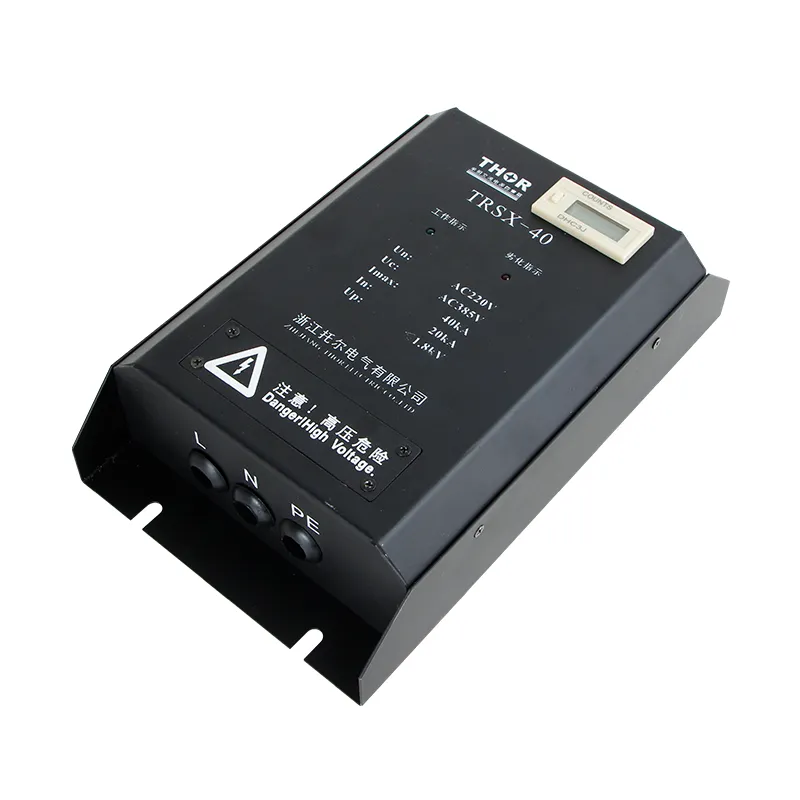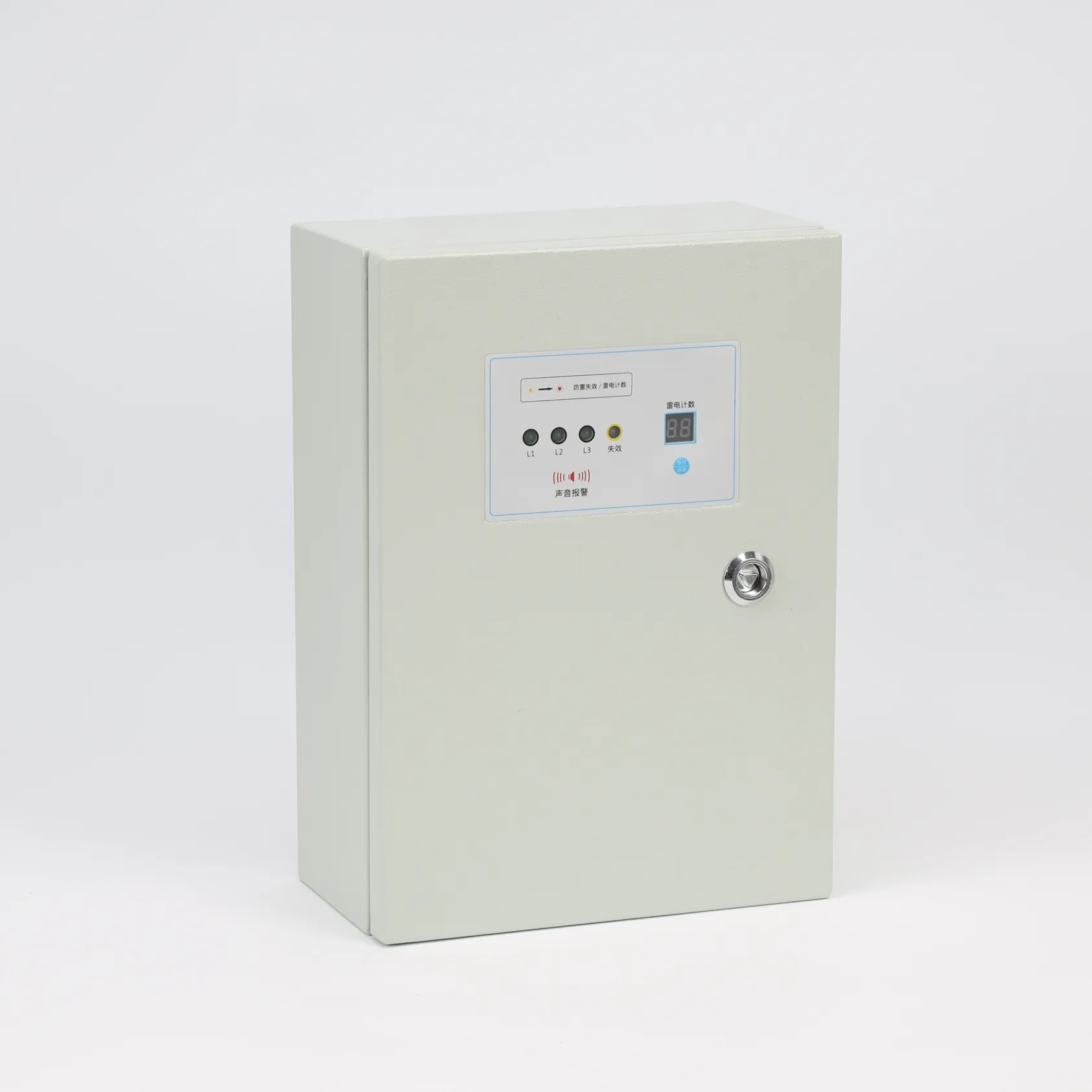Lightning is unpredictable and poses a serious threat to buildings and people within the affected area. The hazards of lightning mainly include the following aspects:
- Destroy the building structure
- Damage electrical equipment in the building
- Cause fire
- Constitute personal safety risks to personnel
The function of lightning protection box
Electrical equipment such as lightning counters and surge protective device are installed inside the lightning protection box. It is mainly used for lightning surge overvoltage protection in distribution systems and is used to protect electronic and electrical equipment from lightning electromagnetic pulse induced voltage, operating transients, and resonance overvoltage. It is widely used in power system protection in fields such as communication equipment, electricity, security, transportation, and industrial control.
The lightning counter accurately records the number of lightning strikes.
The status indicator light indicates the working status of the lightning protection box.
The discharge current is large and the residual voltage is low.
Wide range of use and fast response speed.
It is simple and convenient to install and requires no special maintenance.
Installation Notes
When installing a lightning protection box, the power supply must be cut off, and live work is strictly prohibited.
When installing a distribution box, it is necessary to ensure that all mechanisms such as the box, door, locks, and copper bars are assembled firmly and reasonably. Before installation, you should also carefully check whether the electrical connection joints in the box are firmly connected and whether the cable insulation is in good condition.
Distribution boxes are generally wall-mounted or vertically installed. Wall-mounted installations should be fixed in strict accordance with local building regulations to ensure the stability and safety of the distribution box. For vertical installation, use pillars or anchor bolts to ensure that the distribution box is not easy to tip over.
During the use of the lightning protection box, you should regularly check the working status of the indicator light: if the indicator light is green, it means that the power supply and lightning protection of the lightning protection box are normal; if it is red, it means that the internal components of the lightning protection box have aged and need to be Repair and replace in time.
Lightning protection box equipped with a lightning counter, its counting range is 0~99.
The connecting wire should be multi-stranded copper wire no smaller than the standard requirements and should be short, thick, and straight.
Non-professionals are not allowed to disassemble it.
The difference between indoor and outdoor lightning protection boxes
Product design and installation location are the main differences between indoor lightning protection boxes and outdoor lightning protection boxes.
Product design: Indoor lightning protection boxes are usually smaller in size and exquisite in appearance, and are not as good as outdoor lightning protection boxes in terms of weather resistance. Outdoor lightning protection boxes can resist the influence of rain, ultraviolet rays, and other environmental factors, and have stronger weather resistance.
Installation location: Indoor lightning protection boxes are used to be installed inside buildings, such as power distribution rooms. Outdoor lightning protection boxes are used for installation outdoors, such as power entry points.
Considerations for the installation location of distribution boxes
The distribution box should be installed in a location that complies with the building structure and balance principles, and avoid installation in exposed sites or in the air during construction to prevent theft and safety accidents. At the same time, the distribution box should also be kept at a certain distance from damp, flammable, explosive and other places and objects to prevent accidents such as fires.
Regularly inspect and maintain lightning protection boxes
Lightning protection systems are important measures to protect buildings, equipment and personnel from lightning hazards. During the use of the lightning protection system, due to the influence of the natural environment, human factors or lightning itself, problems such as corrosion, loosening, breakage, damage, etc. may occur, affecting its protective effect and even causing lightning accidents. Therefore, regular maintenance of the lightning protection system is an important part of lightning protection work and a necessary condition to ensure the safety of life and property.
The purpose of regular inspection and maintenance is to conduct comprehensive inspection, testing, repair and improvement of the lightning protection system, eliminate safety hazards, improve the level of protection and extend the service life.
Check the lightning protection box, including potential equalization connections and surge protection device on metal enclosures, racks, etc.
Check the form, quantity, location, length, cross-sectional area, material, etc. of the potential balancing connections of metal casings, racks, etc. Whether the potential balance connection is corroded, loose, broken, worn, etc.; whether the connection between the potential balance connection and the external lightning protection system is firm and reliable; whether the potential balance connection is kept at a sufficient distance from other metal pipelines, cables, etc.; whether the potential balance connection is Protective measures to prevent man-made damage or lightning induction. Use a multimeter or a special measuring instrument to measure the resistance of the potential equalization connection.
Check the type, quantity, location, parameters, wiring method, etc. of the surge protection device. Whether the surge protection device is corroded, loose, open, short-circuited, fused, heated, leaked, etc.; whether the connection between the surge protector and the external lightning protection system is firm and reliable; whether the connection between the surge protection device and the protected equipment is correct; Does the surge protector have protective measures to prevent man-made damage or lightning induction? Check whether the surge protective device can work normally, whether it is faulty or damaged, and whether it needs to be replaced or repaired.
Maintain lightning protection boxes, including potential equalization connections and surge protectors on metal enclosures, racks, etc.
Replacement or repair of potential balancing connections. Potential balancing connections that are corroded, loose, broken, worn, etc. should be replaced or repaired in time to ensure the integrity and stability of the potential balancing connections.
Replacement or repair of surge protection device. Faulty or damaged surge protectors should be replaced or repaired in time to ensure the normal operation of the surge protective device.



